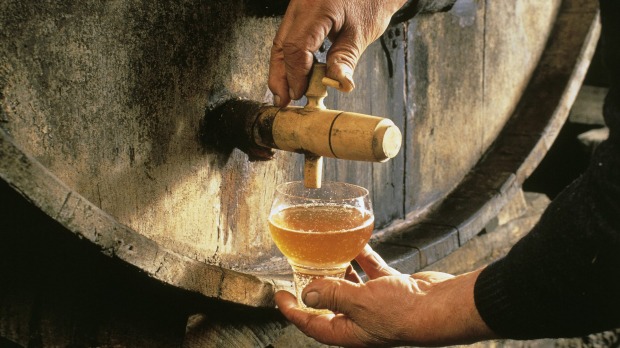
Like craft beer, boutique ciders are taking off in fashionable bars and at food and wine festivals around Australia. I'm very fond of a drop of chilled, dry, traditionally made cider, but until recently it's been hard to find anything other than sweet, mass-produced stuff here. So among the many things I was looking forward to on an 11-night round-trip cruise from Paris through the northern region of Normandy was the chance to taste French cider at its source.
Travelling through the countryside that inspired impressionist masters such as Claude Monet and Vincent van Gogh was right up there too, of course, as was refreshing my limited reserves of the French language – but sampling Normandy's cider, calvados and sublime cheeses added another delicious dimension to the journey.
My first taste of Normandy cider was on board the new Scenic Gem, a 128-passenger river ship specially designed for cruising the Seine. Stefan, the Bulgarian barman, had several local varieties tucked away behind the bar. He served it in champagne glasses – very appropriate, seeing as cidre bouché actually means the cider has had its second fermentation in champagne-style bottles. Stefan explained that there are two types of cidre, brut (dry) and doux (sweet) – the alcohol content is about five per cent and three per cent, respectively.
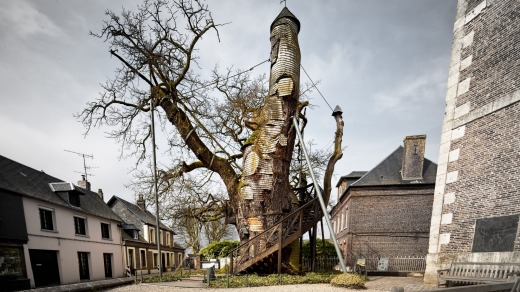
The next cider experience was at Le Pressoir d'Or, a flower and cider farm near Lyons-la-Forêt, an unbelievably picturesque village that is famous for its 17th- and 18th-century half-timbered houses. On the 30-hectare estate there are 15 varieties of cider apples and about 19,000 trees and owner Eric Dore takes you through the cider-production processes, from picking the fruit to fermentation and on to tasting in the 17th-century barn. It's subtle and sweeter than some English and Australian ciders, and eminently drinkable.
Le Pressoir d'Or has a showroom of antique presses and cider-making implements. Cider has been produced in Normandy since the Middle Ages and the cider press was invented in the 13th century. The following day, in a busy square in Rouen, we spotted a man serving cider straight from one of these original presses. He was surrounded by eager customers, so rather than join the throng we got on with our research into some regional specialities – seafood, cheese, tarte Normande and local rosé – at a charming café.
Normandy is heaven for cheese lovers. Scenic offers guided tours of the 16th-century Domaine Saint-Hippolyte, 40 kilometres from Honfleur. You see the dairy through a glass corridor, which reveals the cheeses in various stages of production, along with an educational video about making Normandy's four appellation d'origine protégée (AOP) cheeses. Under this system, Camembert de Normandie, Livarot, Pont-l'Évêque and Neufchâtel are all certified as being produced from grass-fed Normandy cows – those lovely brown-and-white beasts with the distinctive sunglasses eye markings you see grazing in lush green Normandy pastures and orchards. AOP cheeses are made by hand, as at Domaine Saint-Hippolyte, straight from milk produced by cows on the farm; nothing is mass-produced.
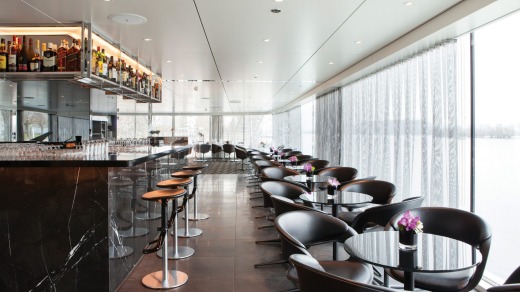
The estate has several hectares of apple orchards and supplies local cider makers with the fruit, rather than producing it on site. However, we were offered a glass to accompany the cheese tasting. Which was, as expected, superb. Apples are also used to make jellies, jams, desserts, calvados (a cider brandy known as la goutte, or a nip) and Bénédictine.
Scenic runs an excursion to Deauville, the seaside playground of Paris' glitterati in the heart of Calvados, apple brandy country. There are many cellar doors where you can sample a drop of the strong stuff, or enjoy apple ice-cream with a calvados shot, a traditional palate cleanser known as trou normand. We called in at the Christian Drouin Calvados Estate, which is set on a former cider farm at Coudray-Rabut. Several of the original 17th-century buildings are still in use for processing cider, Pommeau de Normandie (a potent blend of apple juice and calvados) and calvados.
Here we learned about the different types of apples grown in the estate's orchards (they are all gathered by hand during three different seasons), and the methods employed in mashing, pressing and distilling the apples. One of the estate's stills was built in 1946 but as production increased over the years a second still was installed in 1993. Drouin calvados is aged in oak casks, some of which are former sherry or port casks, for five, 10 or 20-plus years. The best drinking advice is to savour it slowly at the end of a meal.
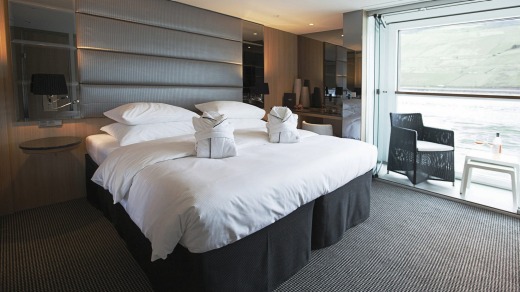
We also had the opportunity to visit the Bénédictine palace in Fécamp when we docked at the historic town of Caudebec-en-Caux. This pretty town boasts a 15th-century church and the 12th- to 13th-century Maison des Templiers, one of the oldest houses in Normandy. On the way to Fécamp we passed the curious oak-tree chapel in the village of Allouville-Bellefosse. Our guide said the tree was about 1000 years old; the two chapels inside its hollow trunk were built in 1669 and are still used today.
The ornate Bénédictine palace is comparatively modern, having been built in 1898 by a local wine merchant, Alexandre Le Grand. However the story of Bénédictine goes back to 1510, when a monk at the Abbey of Fécamp created the secret elixir. Monsieur Le Grand discovered the recipe some 350 years later among his collection of religious art and set about producing the liqueur, which has remained the same ever since.
The original palace-factory burnt down in 1892, but the bigger and better neo-Gothic, neo-Renaissance building that replaced it continued the production of Bénédictine. It houses a collection of 15th- and 16th-century religious objets d'art and a modern art gallery, but it's the vast distillery in the cellar that attracts most visitors.
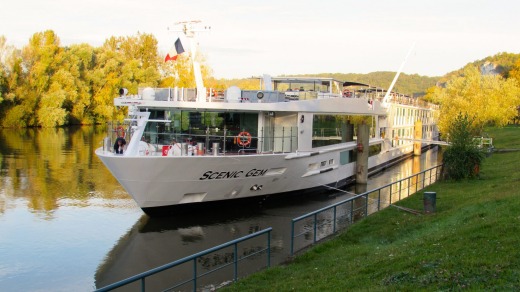
Twenty-seven herbs and spices go into the liqueur, which takes two years to produce in a series of infusions, distillation in old copper stills, blendings and double-distillation. It's a spicy, aromatic liqueur that works very well with tonic water and a wedge of lime, or in the Apprentice, a cocktail containing grapefruit juice. Naturally, there are tastings and a boutique stocked with Bénédictine and good quality souvenirs to remind you of a fascinating journey into Normandy's past and present.
TRIP NOTES
MORE INFORMATION
www.scenic.com.au
GETTING THERE
Scenic Gem sails 11-day itineraries on the Seine, starting and ending in Paris, from April to October. Fares start at $6,945 for the April 26 departure. Book by October 31, 2015 for free return airfares for 2016 Gems of the Seine cruises.
STAYING THERE
The Gems of the Seine cruise visits Les Andelys, Rouen (for two days), Honfleur (for two days), Caudebec-en-Caux, Vernon and Conflans.
DINING THERE
Scenic Gem's main Crystal Dining restaurant serves buffet breakfast and lunch, and à la carte dinner, with wines included. L'Amour restaurant seats 32 for a five-course dinner and Table La Rive is an invitation-only venue for Diamond deck passengers. River Café is open all day for light meals and snacks.
FIVE MORE THINGS TO DO
GO CYCLING
Book one of the ship's regular or electrically assisted e-bikes for a relaxing ride around any of the towns or villages visited on the cruise. Climbing the steepest hill is a breeze on an e-bike.
TASTE
Take the ship's tour to the French Baking and Patisserie Institute (Institute National De La Boulangerie Pâtisserie) in Rouen for a cooking demonstration followed by tasting. Traditional bread-making methods in France are protected by law – thankfully!
PAY YOUR RESPECTS
Scenic Gem offers a day tour from Rouen to the Somme battlefields. The infamous Battle of the Somme between July and November 1916 took the lives of more than 150,000 soldiers from Britain and the Commonwealth. A visit to the Australian National Memorial near Villers-Bretonneux is part of the tour.
VISIT VAN GOGH'S LAST ROOM
Auvers-sur-Oise is the village where Vincent van Gogh lived and painted in 70 days leading to his death in 1890. His attic room in the Auberge Ravoux has been preserved intact; many places that he painted around the village remain the same today.
INDULGE
Treat yourself to a lavish lunch in one of Honfleur's dozens of restaurants. Moules, oysters, fish dishes, locally sourced meat, rich creamy desserts and Normandy cheeses are on every menu and waterfront dining doesn't come much more picturesque than in this historic port.
.